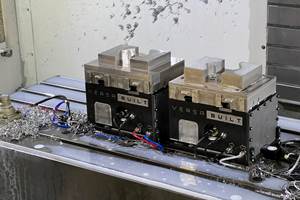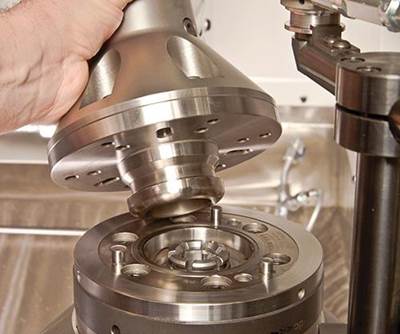Navigating Large-Scale CNC Machining: Suburban Tool’s Niche Strategy to Stay Competitive
Facing increasing competition from lower-cost imports, Suburban Tool made a move toward large-scale, in-house machining. By identifying a niche in large, precision angle plates and tombstones, the company has strengthened its ability to control quality and protect its reputation.
Share



Hwacheon Machinery America, Inc.
Featured Content
View More





Don Bailey, CEO of Suburban Tool Inc., stands inside of the company’s latest addition, a Mazak HCN 10800. The machine, along with Suburban Tool’s Mazak FH 8800 and FH 680, is enabling the company to expand the range of products it machines in-house. Source (all photos): Suburban Tool.
“We don’t like to outsource.”
This was one of two key motivations for Suburban Tool’s recent shift toward producing its large tombstones and angle plates in-house rather than having them machined off-site, says Kevin Heintz, the company’s lead sales engineer.
The second motivation was competition. Suburban Tool has earned a long reputation as a top-tier manufacturer of American-made precision workholding and inspection equipment, producing most of these products in its Auburn Hills, Michigan, facility. When leadership felt the company was being undercut by lower cost fixturing and workholding equipment being mass-produced overseas, they did what many savvy business leaders would do: They targeted an in-demand niche product and worked toward streamlining its production.
Large, cast-iron angle plates were among the few products in its catalog that Suburban Tool outsourced — the company simply lacked any large-format machines capable of handling the castings. But a chance purchase opportunity arrived one day when Heintz and Suburban Tool President Paul Van Every learned that Mazak had an HCN 10800 horizontal machining center sitting on a dock, having been abandoned by another customer who canceled their order. The 10800 is a high-speed, heavy duty horizontal mill capable of handling workpieces more than 80 inches in diameter, including the large angle plates and tombstones that Suburban Tool had been outsourcing for years.
With the 10800 now up and running on the shop floor, it has not only created new production opportunities for the company, it also has become an integral part of the company’s long-term strategy.
Holding Two-Tenths as an Artform
From what I witnessed during my visit, Suburban Tool prides itself on two key qualities: adhering to exacting production requirements and committing to domestic production using local supply chains. The company’s primary offerings are centered around workholding tools and inspection equipment — two distinct product lines that the company’s CEO, Don Bailey, set in motion when he purchased the business in the mid-1970s. In one of Bailey’s early YouTube videos where he introduces Suburban Tool’s products and philosophy, he offers a clear vision about what sets the company apart: Artistry.
“Most of our guys are on grinders, and what we do all day long is hold two-tenths,” he says. “It’s like falling out of bed. If you look at our products, you’ll see that almost everything we make is within two-tenths square, parallel, flatness. Our focus is not so much on the mechanical side, but in the break between mechanical and artistic. And we can do that for you by showing you the artistic side and making that transition from being a mechanic to being an artist.”

One of Suburban’s skilled machinist works inside the Mazak HCN 10800, measuring the T-slots on a large angle plate.
Why In-House Production Makes Sense
Today, Van Every and Sales Engineer Kevin Heintz are largely responsible for staying true to that dual focus. During my recent tour of the company, I found that attention to detail outshines flashy displays of modern technology on the shop floor. While the Suburban Tool has invested more than $2 million in updated equipment recently, there still is an element of continuity here, with some of the company’s grinding machines and CNC mills dating back to the 1980s and 90s still producing parts. But progress doesn’t have to mean employing the latest in robotics and digital simulation software. It can also mean sustaining high quality and repeatability standards over the span of decades, oblivious to changes taking place in the outside world.
For example, even Suburban Tool’s largest angle plates are machined flat, square and parallel within 0.001 inch per foot. Outsourcing the machining of larger work like this, Heintz says, meant trusting that someone else would achieve the parallelism, surface finish and quality. The only way to fully ensure that tolerances are met every time — and protect the brand’s integrity — was to keep production in-house. This time, that meant investing in new capital equipment.
What Heintz and Van Every had learned was that outsourcing the large workholding jobs was rife with its own set of challenges. Take a recent quote the company provided to a customer: It was for a large cast iron angle plate 66-inches tall, 48-inches wide and 30-inches deep. Using Autodesk Inventor, Heintz drew up a print of the finished product including all the hole slots and special features, determined the final weight of the part and calculated the cost for the raw casting and on-machine time. He then contacted the local foundry to determine lead times — about eight weeks for the casting plus an additional few days to be heat treated at a separate facility — and sent a quote that estimated delivery of the finished piece in 12 to 14 weeks.
Outsourcing the machining would have resulted in not only a longer lead time — time that would have been beyond Suburban Tool’s ability to control — but also added costs for the subcontractor as well as additional time tacked on to the back end for inspection and quality control. Shifting to in-house production has alleviated several of these concerns. “We’ve always been known for our high-quality tools,” Heintz says. “But when you outsource, you’re trusting someone else to meet your standards. By keeping production in-house, we know that our tolerances are met every time.”
The decision to acquire the Mazak 10800 came at the right time. “We had a couple of older mills that were getting tired,” Heintz says. When he and Van Every learned from Mazak that an order for a new 10800 had been canceled and the machine was sitting on a dock waiting for a new buyer, it was a no-brainer, Heintz says. “It gave us bigger capacity and a chance to take on larger orders. A win-win all around.”
Related Content
Parts and Programs: Setup for Success
Tips for program and work setups that can simplify adjustments and troubleshooting.
Read MoreChuck Jaws Achieve 77% Weight Reduction Through 3D Printing
Alpha Precision Group (APG) has developed an innovative workholding design for faster spindle speeds through sinter-based additive manufacturing.
Read MoreRail Manufacturer Moves Full Steam Ahead with Safe, Efficient Workholding Solution
All World Machinery Supply paired a hydraulic power unit with remote operating capabilities in a custom workholding system for Ahaus Tool & Engineering.
Read MoreUsing Jaws as Grippers Enables Flexible, Low-Cost Automation
VersaBuilt’s automation systems significantly boosted Innovative Fabrication’s revenue. In return, the shop has helped VersaBuilt optimize its products.
Read MoreRead Next
Workholding Cuts Setup Time for Cylindrical Gears
A new generation of modular, quick-change workholding systems requiring fewer tools, less time and minimal operator experience has arrived.
Read MoreBuilding Out a Foundation for Student Machinists
Autodesk and Haas have teamed up to produce an introductory course for students that covers the basics of CAD, CAM and CNC while providing them with a portfolio part.
Read MoreRegistration Now Open for the Precision Machining Technology Show (PMTS) 2025
The precision machining industry’s premier event returns to Cleveland, OH, April 1-3.
Read More



































.jpg;maxWidth=300;quality=90)









